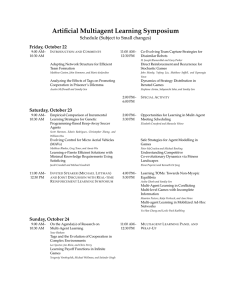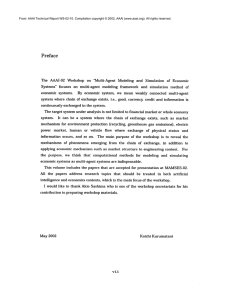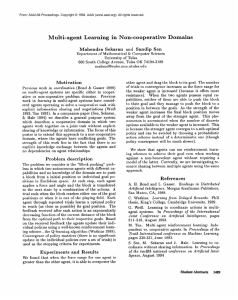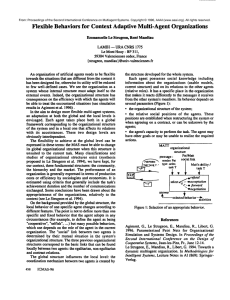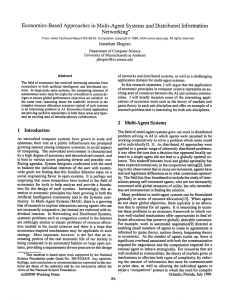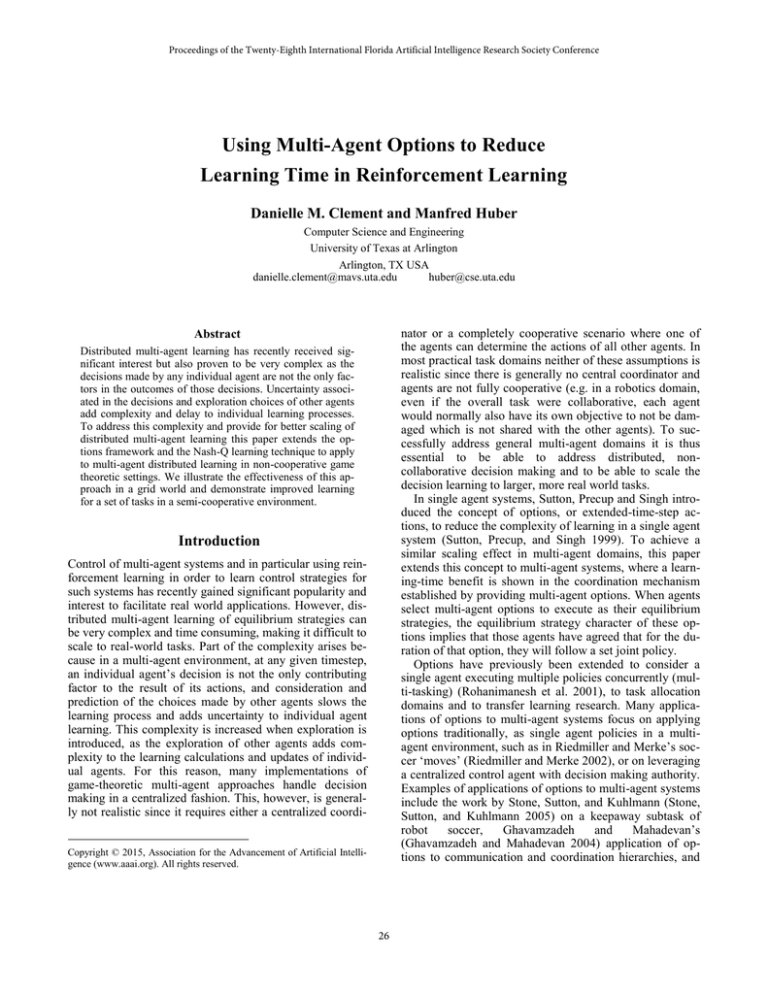
Proceedings of the Twenty-Eighth International Florida Artificial Intelligence Research Society Conference
Using Multi-Agent Options to Reduce
Learning Time in Reinforcement Learning
Danielle M. Clement and Manfred Huber
Computer Science and Engineering
University of Texas at Arlington
Arlington, TX USA
danielle.clement@mavs.uta.edu
huber@cse.uta.edu
nator or a completely cooperative scenario where one of
the agents can determine the actions of all other agents. In
most practical task domains neither of these assumptions is
realistic since there is generally no central coordinator and
agents are not fully cooperative (e.g. in a robotics domain,
even if the overall task were collaborative, each agent
would normally also have its own objective to not be damaged which is not shared with the other agents). To successfully address general multi-agent domains it is thus
essential to be able to address distributed, noncollaborative decision making and to be able to scale the
decision learning to larger, more real world tasks.
In single agent systems, Sutton, Precup and Singh introduced the concept of options, or extended-time-step actions, to reduce the complexity of learning in a single agent
system (Sutton, Precup, and Singh 1999). To achieve a
similar scaling effect in multi-agent domains, this paper
extends this concept to multi-agent systems, where a learning-time benefit is shown in the coordination mechanism
established by providing multi-agent options. When agents
select multi-agent options to execute as their equilibrium
strategies, the equilibrium strategy character of these options implies that those agents have agreed that for the duration of that option, they will follow a set joint policy.
Options have previously been extended to consider a
single agent executing multiple policies concurrently (multi-tasking) (Rohanimanesh et al. 2001), to task allocation
domains and to transfer learning research. Many applications of options to multi-agent systems focus on applying
options traditionally, as single agent policies in a multiagent environment, such as in Riedmiller and Merke’s soccer ‘moves’ (Riedmiller and Merke 2002), or on leveraging
a centralized control agent with decision making authority.
Examples of applications of options to multi-agent systems
include the work by Stone, Sutton, and Kuhlmann (Stone,
Sutton, and Kuhlmann 2005) on a keepaway subtask of
robot
soccer,
Ghavamzadeh
and
Mahadevan’s
(Ghavamzadeh and Mahadevan 2004) application of options to communication and coordination hierarchies, and
Abstract
Distributed multi-agent learning has recently received significant interest but also proven to be very complex as the
decisions made by any individual agent are not the only factors in the outcomes of those decisions. Uncertainty associated in the decisions and exploration choices of other agents
add complexity and delay to individual learning processes.
To address this complexity and provide for better scaling of
distributed multi-agent learning this paper extends the options framework and the Nash-Q learning technique to apply
to multi-agent distributed learning in non-cooperative game
theoretic settings. We illustrate the effectiveness of this approach in a grid world and demonstrate improved learning
for a set of tasks in a semi-cooperative environment.
Introduction
Control of multi-agent systems and in particular using reinforcement learning in order to learn control strategies for
such systems has recently gained significant popularity and
interest to facilitate real world applications. However, distributed multi-agent learning of equilibrium strategies can
be very complex and time consuming, making it difficult to
scale to real-world tasks. Part of the complexity arises because in a multi-agent environment, at any given timestep,
an individual agent’s decision is not the only contributing
factor to the result of its actions, and consideration and
prediction of the choices made by other agents slows the
learning process and adds uncertainty to individual agent
learning. This complexity is increased when exploration is
introduced, as the exploration of other agents adds complexity to the learning calculations and updates of individual agents. For this reason, many implementations of
game-theoretic multi-agent approaches handle decision
making in a centralized fashion. This, however, is generally not realistic since it requires either a centralized coordiCopyright © 2015, Association for the Advancement of Artificial Intelligence (www.aaai.org). All rights reserved.
26
Trigo and Coelho’s (Trigo and Coelho 2007) jointintention multi-agent option model.
Stone, Sutton, and Kuhlmann (Stone et al. 2005) focus
on keepaway (a subtask of robot soccer). While those
agents use options to coordinate passing behavior among
teammates, they are single-agent options and the selection
of those options is carried out by only one teammate (only
the ball-possessor selects an option). Using collaborative
options to support joint decision making is not addressed.
Ghavamzadeh and Mahadevan (Ghavamzadeh and
Mahadevan 2004) extend the options framework to multiagent systems in a purely cooperative task. Their work
focuses on using an options-informed framework to determine when agents would be best served to coordinate and
retrieve information about other agents’ intended action
choices in a hierarchical task structure, but does not focus
on team behaviors other than to maximize total system
utility. Their work is extended by Cheng, Shen, Liu, and
Gu (Cheng et al. 2007) to learn options at multiple levels in
the task hierarchy, but that work also does not look at options to facilitate teamwork, but rather as a mechanism to
maximize the total system utility. Recent work in DecPOMDPs (Amato, Konidaris, and Kaelbling 2014) also
extends the options framework to multi-agent systems, and
similarly focuses on purely cooperative domains.
Trigo and Coelho (Trigo and Coelho 2007) describe options as a set of intentions for individual systems, and describe a hierarchical approach where the intentions of individual agents are coordinated into the intentions of the total
group of agents. At each decision epoch in their model, the
agent can choose whether to select an action individually
or request that one be selected for them by the collective.
The collective and individual policies are motivated by
different goals and are learned in parallel. The primary
difference between their work and the structure we are
about to describe is the selection of opportunities to collaborate via a centralized collective versus the selection of
specific collaboration behaviors by individual agents.
Options have proven to be an efficient mechanism to
speed learning time for single agents by Provost, Kuipers,
and Miikkulainen (Provost, Kuipers, and Miikkulainen
2004) who compared learning effectiveness in a robotsensing environment between options-enabled and primitive action learners. They concluded that options-enabled
learners were able to rapidly identify critical areas of the
state space because options moved high-value, distant rewards through the learning system more efficiently.
In this paper, we briefly cover the techniques which
have been extended by this research, describe the approach
taken to develop joint multi-agent options in general, noncooperative settings, describe an experiment on learning
speed and action selection in a grid world with collaborative and competitive aspects, and present conclusions.
Options
Options, as described by Sutton, Precup and Singh (Sutton
et al. 1999), provide a mechanism in single agent systems
to extend actions over multi-step time scales. Formally,
options (π, τ, I) are described as being comprised of:
a policy π: S × Ap→[0,1] where S is the set of all
states and Ap is the set of primitive actions, where π
represents the probability of the corresponding action;
a termination condition τ: S ×Ap →[0,1] where S is
the set of all states and Ap is the set of primitive
actions, where τ represents the probability of terminating the option;
an initiation set I ⊆ S.
When in an initiation state, an agent has the ability to select an option associated with that initiation state. Once an
option has been selected, an agent will follow the policy
associated with that option until that option terminates per
τ. Primitive, or single-step, actions can also be defined as
options, and combined with the SMDP work of Bradtke
and Duff (Bradtke and Duff 1995), the Sutton, Precup and
Singh paper defines policies over options, thereby enabling
temporal hierarchies of behavior. Using this hierarchical
SMDP learning has been shown to have the potential to
significantly accelerate learning and to allow for larger
problems to be learned than could be done using only
primitive actions. (Provost et al. 2004)
Nash-Q
Nash-Q is a reinforcement learning algorithm that extends
Q-learning to the game-theoretic multi-agent domain.
Since in these domains greedy utility maximization by
each agent is no longer a viable solution, Nash-Q learns
instead a game-theoretic equilibrium strategy. In particular,
Nash-Q learning for multi-agent systems (Hu and Wellman
2003), uses the Nash Equilibrium as the update feature for
Q-learning as opposed to the max. This was chosen as a
mechanism to address the fact that learning in multi-agent
systems is challenging due to the uncertainty associated
with other agents’ explorations and that an agent who possesses some knowledge about the choices, benefits or rewards of other agents can improve their learning by making decisions informed by that knowledge in addition to
reasoning about their own behavior.
A Nash-Q learner learns in a distributed fashion and reasons that the other agents within a system will behave rationally (in a game-theoretic sense) in future interactions,
and therefore selecting an equilibrium behavior will prove
more advantageous in semi-cooperative games than selecting an independent max behavior.
Nash-Q, formally, extends the traditional Q-value update
equations for reinforcement learning:
𝑄𝑡+1 (𝑠𝑡 , 𝑎𝑡 ) = (1 − 𝛼𝑡 ) ∗ 𝑄𝑡 (𝑠𝑡 , 𝑎𝑡 ) +
(1)
𝛼𝑡 [𝑅𝑡 + 𝛽 max 𝑄𝑡 (𝑠𝑡+1 , a)]
𝑎
where 𝛼𝑡 is a learning rate and β represents a discount
factor and 𝑅𝑡 is the learner’s reward at time 𝑡 to stochastic
multi-agent games as
Background
In the work described in this paper we will extend two
primary concepts, options and Nash-Q.
27
tion state or (b) when it is detected that the other agents are
not participating in the selected option. This detection happens immediately after the first action is taken within an
option, as the current implementation is fully observable.
Other termination schemes for agent non-selection or early
exit from an option choice will be addressed in future
work.
At each decision epoch, the players use Nash-Q to determine the Nash equilibrium action they will play for the
next cycle. This selected action could be a primitive action
or a multi-agent option. If both players choose to play the
same multi-agent option, they are effectively choosing to
collaborate for the duration of that option. For the purposes
of this work, Nash equilibrium are identified by the GAMBIT game theory tool suite (McKelvey, McLennan, and
Turocy 2011).
An individual player Pi’s decision process is as follows:
1. Pi selects an action (either primitive or multi-agent
option) for the current state s per the learning
method used (in this case Nash-Q, but the process
can be generalized). In this case, the selection
process is per Nash-Q, and will satisfy a Nash
equilibrium strategy when the available actions to
consist of all primitive options and all multi-agent
options where s is a member of that option’s
initiation set and Pi is a member of the set of
participating players for that option.
2. All players execute their selected actions and
receive observations. If a player has selected a
multi-agent option, the primitive action to execute
is selected based on the player’s policy πi
associated with that multi-agent option.
3. Pi updates the Q-value of the current state s for the
primitive actions that were taken.
4. If all participating players are executing a multiagent option, and that option has terminated, Pi
updates the Q-value for the initiation state of that
option with the discounted cumulative reward
associated with executing that option.
5. If Pi is executing an option and all participating
players are also executing that option, Pi’s next
action for the new state is selected from the
associated policy πi and return to step 2. Otherwise
(including the case where all participating players
are not executing the option), return to step 1.
Primitive actions are updated per the standard Nash-Q
process, but updating the value of the options is handled
slightly differently. After an option 𝑜 has completed, the
value of its initiation state 𝑠0 is updated per Eq. 3.
𝑖
𝑄𝑡+1
(𝑠𝑡 , 𝑎1 , … , 𝑎𝑛 ) = (1 − 𝛼𝑡 ) ∗
(2)
𝑖
𝑄𝑡 (𝑠𝑡 , 𝑎1 , … , 𝑎𝑛 ) + 𝛼𝑡 [𝑅𝑡𝑖 + 𝛽 𝑁𝑎𝑠ℎ𝑄𝑡𝑖 (𝑠 ′ )]
where 𝑁𝑎𝑠ℎ𝑄𝑡𝑖 (𝑠 ′ ) is the expected payoff of the Nash
equilibrium strategy of the stage game associated with the
next state Q-values. Selection of that equilibrium strategy
consistently across agents is one of the challenges of NashQ. For the initial implementation, Hu and Wellman selected the first equilibrium.
Nash-Q learning is a commonly used learning algorithm
in multi-agent domains and we extend it to the situation
where agents can use multi-agent options as action choices.
Approach
In this paper we will expand on the concept of an option
from single agent reinforcement learning to allow for hierarchical learning with extended time actions in multi-agent
domains. For this we will extend the concept of the single
agent option to the game theoretic multi-agent setting and
integrate it into a hierarchical multi-agent learning framework. We will illustrate the effect this has on the value
function update in the Nash-Q learning algorithm and will
finally show the benefit of this in a grid world domain.
A multi-agent option extends a single-agent option as
follows. A multi-agent option (P, π, τ, I) is comprised of:
a set of participating players 𝑃 ⊆ 𝑋, where 𝑋 is the
set of all known agents
a multi-agent policy (i.e. an equilibrium strategy
profile) in the form of a set of policies (one for each
participating
player)
𝜋1…𝑛 : 𝑆 × 𝐴1…𝑛 → [0,1]
where 𝑆 is the set of all states, 𝐴𝑝 is the set of
primitive actions, and 𝑛 is the number of
participating players;
a termination condition 𝜏: 𝑆 + × 𝐴1…𝑛 → [0,1] where
𝑆 + is the set of all states including any termination
states, 𝐴𝑝 is the set of primitive actions, and 𝑛 is the
number of participating players;
an initiation set 𝐼 ⊆ 𝑆.
The primary extension from the standard option framework is the shift from a single agent policy to a set of policies (one for each participating player) which jointly form
a Nash equilibrium strategy for a given task represented by
the multi-agent option. When in an initiation state, each
player has the ability to select a multi-agent option. If all
participating players select the multi-agent option, for as
long as all participating players jointly pursue that option,
those agents follow a previously established collaborative
interaction based on execution of their own individual policies πi. None of the agents should have an incentive to
terminate outside the joint termination condition because
once agents have decided to pursue the “subtask” represented by the option (and do not change their mind), the
fact that the associated policies form a Nash equilibrium
strategy should remove any incentive to deviate from this
strategy. Following this reasoning, for the focus of this
paper, agents terminate execution of a multi-agent option
either (a) when that option reaches a probabilistic termina-
𝑄𝑡+1 (𝑠0 , 𝑜) = [(1 − 𝛼) ∗ 𝑄𝑡 (𝑠0 , 𝑜)] + [∑𝑢i=0 𝛽 𝑖 𝑅𝑖 ] +
(3)
(α ∗ 𝛽 𝑢+1 ∗ 𝑁𝑎𝑠ℎ𝑄(𝑠 ′ ))
where 𝑢 represents the number of timesteps the option
was active, and 𝑅𝑖 is the reward received in intermediate
state 𝑠𝑖 , which is a state traversed during option execution.
For the purposes of this paper, the assessment of whether or not all participating players have selected an option is
handled through the full-observability of the system – all
28
players know via observations exactly which (if any) multi-agent option was selected by each independent agent and
which primitive action was executed immediately after the
first action is executed. Future work will include the assessment of whether or not all participating players are
executing a multi-agent option as well as the termination
responses if agents leave a multi-agent option prematurely.
Table 1. Definition of the initiation states and termination probabilities associated with the six multi-agent options
Move Up To P1y = 0 & P2y = 0 &
Bridge
~(P1x = 1 & P2x = 1)
Move Down
To Bridge
Design of Experiments
To demonstrate the operation and assess the benefits of the
presented hierarchical learning approach using multi-agent
options with Nash-Q, a set of experiments in a two-agent
grid-world domain that contains collaborative and competitive task elements was performed.
The target world for these experiments is the 3x3 grid
world illustrated in Fig. 1. The purpose of the game is for
each player to locate one of two keys and bring it to their
goal to open a player-specific door to a blocked region.
Each key can only be picked up by a single agent when
both agents occupy the same square as the key. To access
the keys, the agents must cross a bridge square, which they
can only enter together. If an agent attempts to enter the
bridge square alone, that agent remains in place. If both
agents attempt to pick up a key, neither agent gets the key.
The game ends when at least one door is opened with the
key, meaning that the agent and a key are in the goal
square and a specific action is taken to open the door. Each
agent is penalized for every time step, making the final
score dependent on the time it takes to retrieve and use a
key. This penalization as well as the difference in reward
between the agent that picks up a key and the agent that
only assists comprises the competitive aspect of the game.
Agents receive a small bonus reward for holding a key and
a slightly smaller reward for the other agent holding a key.
There is a large reward associated with opening the door.
All rewards aggregate at each time step.
In this environment, the states are described by the positions of each player, the positions of each of the keys, and
for each key, which (if any) agent possesses the key. These
parameters describe the available state space S: P1x × P1y
× P2x × P2y × K1x ×K1y ×K2x ×K2y ×K1p ×K2p; where
P1 and P2 represent the players in the game, K1 and K2
represent the keys, x and y represent x and y positions in
2
Key 1 Start
Initiation State
Definition
Option
P1y = 0 & P2y = 0 &
~(P1x = 1 & P2x = 1)
P1y = 2 & P2y = 2 &
Player 1 Gets
K1p = NONE &
Key 1
K2p ≠ P1
P1y = 2 & P2y = 2 &
Player 1 Gets
K1p ≠ P1 &
Key 2
K2p = NONE
P1y = 2 & P2y = 2 &
Player 2 Gets
K1p = NONE &
Key 1
K2p ≠ P2
P1y = 2 & P2y = 2 &
Player 2 Gets
K1p ≠ P2 &
Key 2
K2p = NONE
1 if K1p = P1
0 otherwise
1 if K1p = P1
0 otherwise
1 if K1p = P2
0 otherwise
1 if K1p = P2
0 otherwise
the grid world environment [0,2], and p represents the possession of a given key {NONE, P1, P2}. This results in
59,049 distinct states.
There are six available primitive actions Ap {UP,
DOWN, LEFT, RIGHT, PICKUP, and DROP}. Overall,
there are also six available multi-agent options O {Move
Up To Bridge, Move Down To Bridge, Player 1 Gets Key
1, Player 1 Gets Key 2, Player 2 Gets Key 1, and Player 2
Gets Key 2}. In each of these multi-agent options the joint
policy represents a Nash equilibrium strategy for obtaining
the associated task objective indicated in the name of the
option. Both players must participate in these options (P =
{P1, P2}). Rules defining the initiation states and the termination probabilities associated with these options are
defined in Table 1. All states that meet the criteria indicated in Table 1 are members of the initiation set for that multi-agent option.
A selected example path for two agents from the “move
up” option is illustrated in Fig. 2. Each of the players has
the ability to select a multi-agent option in the associated
start states for that option in addition to the primitive ac-
2
Key 2 Start
Key 1 Start
Key 2 Start
[BRIDGE]
1
[BRIDGE]
1
0
0
Termination
Probability Definition
1 if P1x = 1; P2x = 1;
P1y = 1; P2y = 1
0 otherwise
1 if P1x = 1; P2x = 1;
P1y = 1; P2y = 1
0 otherwise
Player 1 Start
Player 1 Door
Player 2 Start
Player 2 Door
Player 1 Start
Player 1 Door
0
0
1
2
Player 2 Start
Player 2 Door
1
2
Figure 2. A sample path taken by two agents executing the
Move Up To Bridge option
Figure 1. The Grid World
29
um (Harsanyi and Selten 1988). If there were multiple risk
dominant equilibrium, the agents would select the risk
dominant equilibrium that maximized their multiplicatively
combined utility.
tions. No options are available when agents are split (one
in the top row and one in the bottom row) or in the bridge
square itself. The policies associated with the options represent Nash equilibrium strategies for their specific associated subtasks and, while they have been hand-coded in
these experiments, could easily be learned policies via a
sub-goal learning process.
The options themselves are each focused on an aspect of
the game that requires coordination among the players to
be successful, for example, both players being in the same
square as a key with only one player attempting to pick the
key up. This results in some sub-optimal individual behaviors for the agents when seen in relation to their final task
rewards. For example, if an agent is already in the same
square as a key, the other agent is not, and a “get key” option is jointly selected, the agent that is already positioned
correctly will remain in that location (at individual cost)
until the other agent arrives at that position.
If a player selects a multi-agent option and the other
player does not select the same option, the player will terminate option execution and reselect based on Nash-Q.
This is enabled by the fully observable nature of the current implementation and allows our experiment to remain
unconcerned with detecting if the other player has selected
an option. If both players select the same multi-agent option, that option executes until a common termination happens per the termination probabilities.
To determine learning performance, these experiments
were run for 10,000 episodes. Games were run with or
without multi-agent options available. Execution of an
episode continued until a player opened a door or 500
primitive actions were executed. In the learning period,
players would randomly select an option per an exponentially decaying rate (λ) of -0.0005, which would transition
to a 1% exploration rate (ϵ) after the learning period was
completed (episode 8400). Initial Q-values are set to 5,
which is the reward when both players hold keys, without
the movement penalty. In the case where there were multiple equilibria, agents would select risk dominant equilibri-
Results
The score of both agents over the course of their learning is
shown in Fig. 3, with the multi-agent-options-enabled
agents represented with dark lines and the options-free
agents with gray lines. Indications of the time during the
experiments when the exploration rate reaches 0.1 and 0.01
are shown by the black diamonds. The agents with multiagent options available are able to learn the optimal policy
of both agents opening their doors simultaneously. The
agents without multi-agent options available under the
same learning time parameterization are only able to learn
the sub-optimal policy of both agents retrieving keys under
the same parameters. One of the key differences in our
work to previous implementations of options in multiagent systems is that each agent makes decisions based on
individual utility. As seen in these results, the agents with
multi-agent options learn the optimal policy together. Despite the fact that at least one of the non-options-enabled
agents is able to reach the goal during the exploration period, those agents stabilize to a sub-optimal policy when the
exploration period is concluded, because at least one agent
does not have any learned incentive to cooperate beyond
retrieving the keys.
As illustrated in Fig. 4, multi-agent options make more
of the policy space (represented as a percentage of the qtable explored) accessible to agents quickly. Agents are
able to use multi-agent options to leap forward to less easily accessible regions of the solution space and exploit the
rewards available there. This result replicates the single
agent domain findings of Provost, Kuipers, and Miikkulainen (Provost et al. 2004) in a multi-agent domain.
As shown in Fig. 5, agents independently selected to
Individual Player Score
Ɛ = 0.1
Ɛ = 0.01
100,000
10,000
Leading Player -- With Options
Leading Player -- With Options
Lagging Player -- Without Options
Lagging Player -- Without Options
1,000
100
0
1000
2000
3000
4000
5000
Episode
6000
7000
8000
9000
10000
Figure 3. Comparison of the score for each agent in a two agent game with and without multi-agent options. Each point represents the
average score for 100 episodes across 5 runs. The bars represent +/- one standard deviation. The exploration rate decreases exponentially
from 1 at a rate of -0.0005*episode, to a minimum of 0.01. The black diamonds illustrate where the exploration rate (ϵ) = 0.1 and 0.01.
Note these values are plotted logarithmically, and all values have been increased by a constant (1000) to ensure that they are depicted on
this scale. After each run, the leading player was established as the player with the highest average score over the last 100 episodes.
30
collaborate via options a greater percentage of time as they
learned. The spike shown near episode 8000 is due to a
single run with some late exploration on the part of the
lagging player. The variance in option selection is due to
the fact that in some runs, after an initial learning period,
the primitive actions within the option policies replaced the
options themselves. Since options and their underlying
actions initially resulted in the same q-values, and since the
update process was asymmetric (Q-values of primitive
actions were updated as options executed, but options were
not updated when primitive actions aligned with optionbased policies executed), primitive actions have a slight
learning advantage. In a few cases, once a policy was
learned, the behavior was to “dissolve the option” and use
the constituent actions instead. However, it is important to
note that while the final policy no longer uses the options,
it performs the same actions. The agent’s early use of options during learning is essential for the overall learning
process, including the learning of the Q-values of the primitive actions used in the final policy.
Options Selected Per Round
30%
25%
20%
15%
10%
5%
0%
0
2000
4000
6000
Episode
8000
10000
Exploring other selection criteria for equilibrium strategies or implementing other learning algorithms (other than
Nash-Q) within this framework would also be of interest as
an extension to this work.
References
Amato, C., Konidaris, G., & Kaelbling, L. 2014. Planning with macroactions in decentralized POMDPs. AAMAS 2014 (pp. 1273–1280). Int.
Foundation for Autonomous Agents and Multiagent Systems.
In this paper, we have shown that multi-agent options in a
hierarchical reinforcement learning framework establish an
early advantage to learning collaborative techniques. The
pre-established coordination mechanisms available through
these options establish a structure for agents to reach areas
of the solution space that would be limited by the exploration of other agents.
Extending this research to support learned collaborative
options rather than generated options is a logical extension
of this work. Also, further analysis could be done to compare the performance of multi-agent collaborative options
to traditional single agent options. This analysis could determine whether the contribution of multi-agent options
was due to the collaboration inherent in those options, or to
the extended timescale associated with those options. The
collaborative nature of these subtasks would make development of these options difficult without some maintenance of history, since single agent options could get
caught in loops if the other agents were uncooperative (for
example, by trying to simultaneously retrieve a key, thereby blocking both agents).
Ɛ = 0.1
8.00%
Ɛ = 0.01
Figure 5. Options selected per executed round.
Conclusions
Percent QTable
Ɛ = 0.1
35%
Bradtke, S. J., & Duff, M. O. 1995. Reinforcement learning methods for
continuous-time Markov decision problems. Advances in Neural
Information Processing Systems, 7(7): 393.
Cheng, X., Shen, J., Liu, H., & Gu, G. 2007. Multi-robot cooperation
based on hierarchical reinforcement learning. ICCS 2007 (pp. 90–97).
Springer.
Ghavamzadeh, M., & Mahadevan, S. 2004. Learning to communicate and
act using hierarchical reinforcement learning. Proceedings of the Third
International Joint Conference on Autonomous Agents and Multiagent
Systems-Volume 3 (pp. 1114–1121). IEEE Computer Society.
Harsanyi, J. C., & Selten, R. 1988. A general theory of equilibrium
selection in games. (1st ed.). MIT Press Books.
Hu, J., & Wellman, M. P. 2003. Nash Q-learning for general-sum
stochastic games. Journal of Machine Learning Research, 4: 1039–1069.
McKelvey, R. D., McLennan, A. M., & Turocy, T. L. 2011. Gambit:
Software Tools for Game Theory, Version 0.2010.09.01.
Provost, J., Kuipers, B., & Miikkulainen, R. 2004. Self-organizing
perceptual and temporal abstraction for robot reinforcement learning.
AAAI-04 wkshp learning and planning in markov processes (pp. 79–84).
Riedmiller, M., & Merke, A. 2002. Using machine learning techniques in
complex multi-agent domains. Adaptivity and Learning.
Ɛ = 0.01
Rohanimanesh, K., Mahadevan, S., Rohanlmanesh, K., & Lansing, E.
2001. Decision-theoretic planning with concurrent temporally extended
actions. Proceedings of the Seventeenth Conference on Uncertainty in
Artificial Intelligence (pp. 472–479). Morgan Kaufmann Publishers Inc.
With Multi-Agent Options
4.00%
Stone, P., Sutton, R. S., & Kuhlmann, G. 2005. Reinforcement Learning
for RoboCup-Soccer Keepaway. Adaptive Behavior, 13(3): 165–188.
Without Multi-Agent Options
0.00%
0
2000
4000
6000
Episode
8000
Sutton, R., Precup, D., & Singh, S. 1999. Between MDPs and semiMDPs: A framework for temporal abstraction in reinforcement learning.
Artificial Intelligence, 112(1): 181–211.
10000
Trigo, P., & Coelho, H. 2007. A hybrid approach to teamwork. Proc. VI
Encontro Nacional de Inteligncia Artificial (ENIA-07).
Figure 4. Percentage of Q-Table explored with multi-agent options and without multi-agent options.
31

